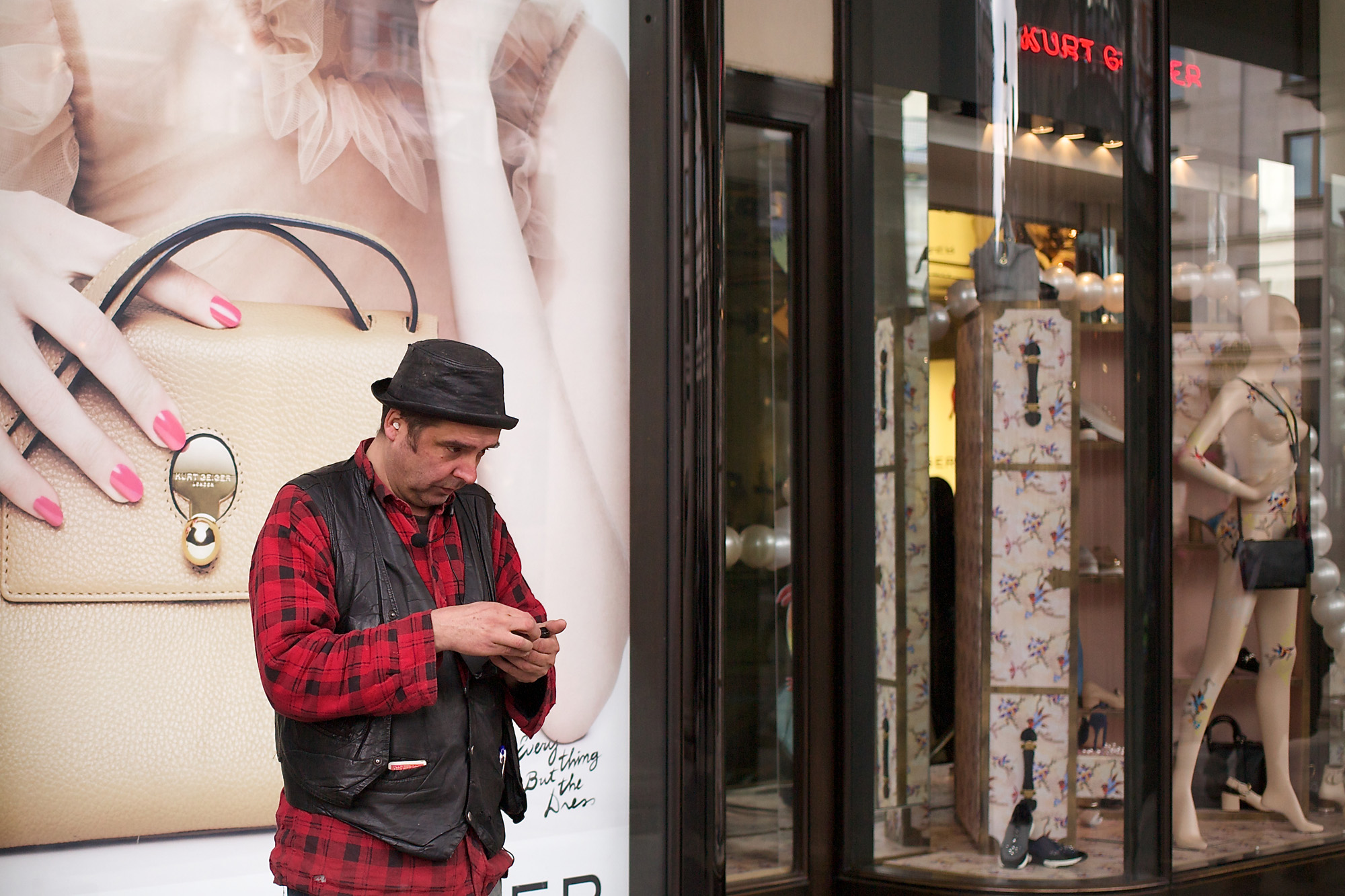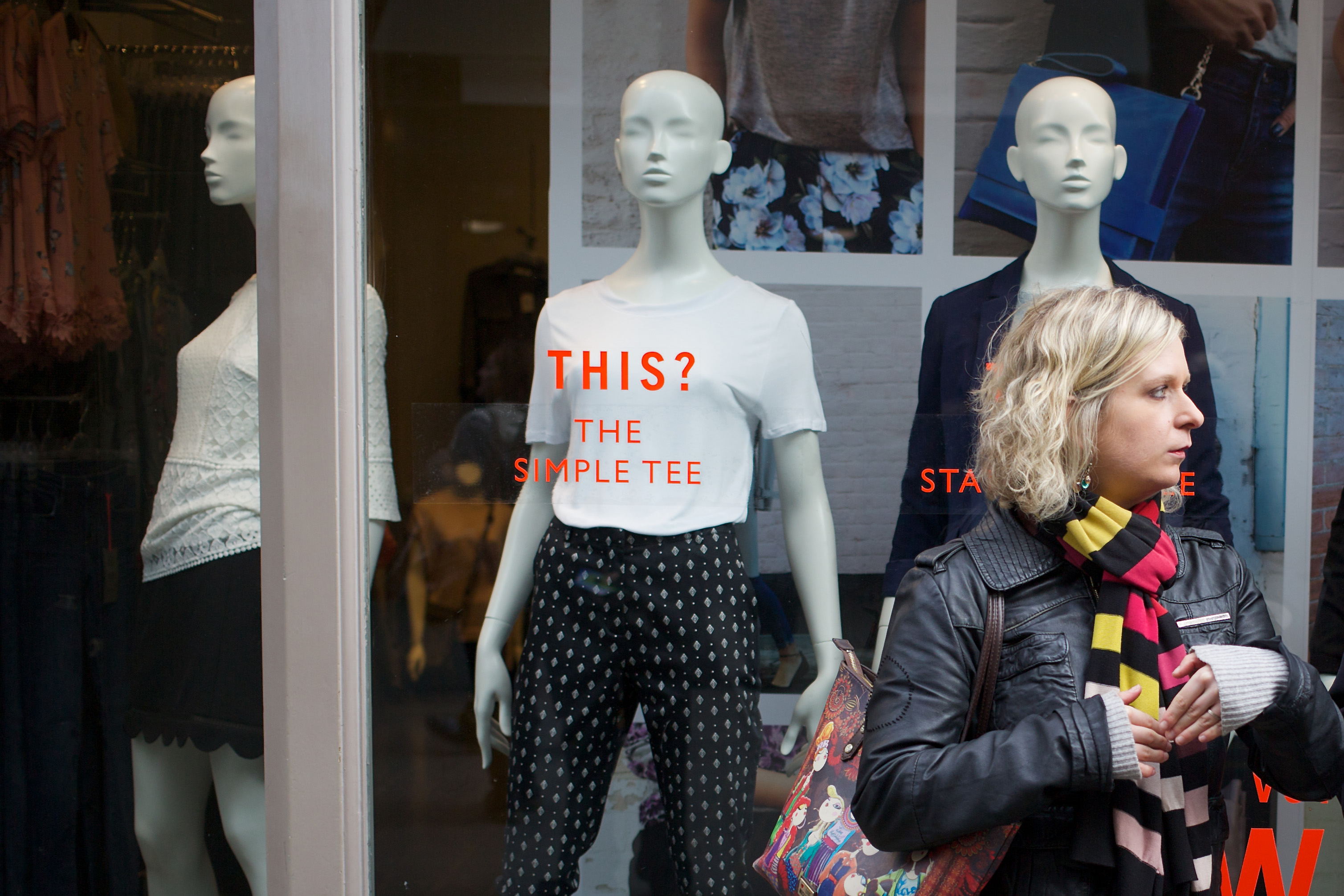Sometimes I like to go window shopping for street photos. Well, why not? If I see a shop window with a particularly intriguing display I like to match it with a real-life subject of equivalent interest.
I need hardly add that this technique works a lot better in London than it does in Bangkok: the two cities where I take most of my pictures. London teems with glass fronted shops, their windows packed with the latest fashions, from elegant to quirky. Bangkok, on the other hand, is a city of malls; its street shops tend to be open at the front, with all the goods further inside.
If you’re a street photographer you can’t really ignore shops altogether — they’re too ubiquitous — so you’d better make the best of them. The potential variations on “person walking past” or “person standing in front of” (the shop) are pretty much endless.
For example, you can have people arguing in front of, canoodling in front of, reading, stretching, yawning, crying (and doing all those things that people normally do elsewhere) in front of the shop.
They could be going into a shop or coming out of it or simply lingering inconveniently in the doorway, much to the annoyance of everyone else. I very much like the idea that life carries on, despite the attempt of shops to persuade us that theirs is the only show in town.
The Good and the Bad
For the street photographer, shop windows have both good points and bad. In their favour is the fact that they’ve mostly been put together by a professional window dresser with a good sense of colour and design. They’re sometimes stunning, often original, and nearly always visually striking in one way or another.
The only big disadvantage of using shop window displays in street photography (apart from them becoming a cliché) is that they tend to be about two feet higher than the sidewalk. The effect is to give all the mannequins a godlike appearance, so that anyone browsing the display will see a race of superbeings, unwilling to stand alongside the common crowd.
Disassembled Mannequins
In one photo (my featured image, above) I’ve solved the problem by selecting a display which has yet to be installed. I loved the way the disassembled mannequins had been arranged — one torso revealing an unusual shade of grey.
I’d noticed the two pedestrians a minute or so previously and saw them approaching the window. Getting a shot without them looking directly at me — yet turning their heads in my direction — was possible because they’d emerged from the other side of a parked van. It was natural for them to look around it, but hard to see anything specific in the first split second. As you can see: you need several strategies to work in your favour if want to get a satisfying shot.
In the above photo, the pedestrians appear to be higher (and hence more prominent) than the figures in the window. There’s also an absence of colour, except in skin tones and from the warm light at the back of the window. The stonework is not entirely neutral and for once looks less severe than it normally does in photos.
The Avoidance of Cliché
As I say, it’s vital to avoid cliché when you combine real people with shop windows. If you can’t avoid it altogether — because “shop window + real people” is itself a cliché — you need to find an original variation.
I think I’ve done this in the next photo (below), partly because the man is himself highly individual: leather hat, matching leather waistcoat, chewing gum in one ear (or is that a hearing aid?). However, what makes it slightly out-of-the-ordinary is the fact that he’s not looking at his phone (if that is indeed what he’s holding) but at something else, out of frame.
In both of these pictures the subjects are looking beyond the frame, having spotted something of interest in the wider world.
I often like to show people gazing, staring into the distance, or simply looking at something other than what I’m looking at (i.e., them). The same is true in the next picture (below), where I’ve tried to make good use of the greater elevation of the sightless mannequins, their non-existent eyes contrasting with the intent gaze of the real woman standing in front of them.
Here I’m drawing attention to the difference between the idealised world of visionary ideas (our many possible futures) and the individualised reality of the human race (our “here and now”). The mannequins are like a race apart, with their distended necks and identical faces. Amazingly confident in their stance they seem to herald the future: robotics, androids, artificial intelligence.
“But no” — the real woman appears to be saying — “the future really belongs to me.”
I hope she’s right.



Where are you shooting these?
Most of the London photos are shot in and around Covent Garden and the West End.